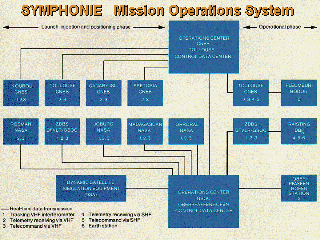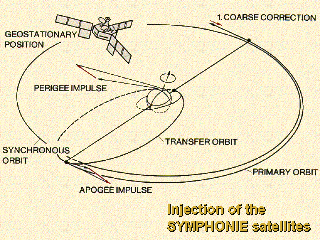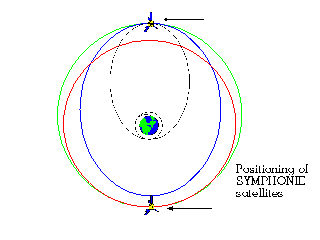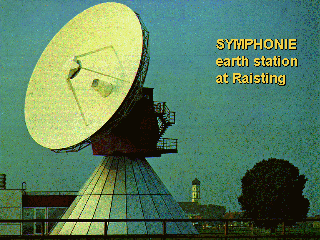 |
Symphonie A
Launch: 12 December, 1974 on THOR DELTA;
Position: 11.5°W, 1977 temporarily moved to 49°E;
de-orbitted: 12 August, 1984
Symphonie B
Launch: 27 August, 1975 on THOR DELTA;
Position: 11.5°W,
de-orbitted: 19 December, 1984 |
Symphonie was a joint German-French telecommunications satellite programme. In
June 1967, the governments of the French Republic and the Federal Republic of
Germany signed an agreement on the definition, development, manufacture, launch and
utilization of two experimental direct broadcasting telecommunications satellites as
well as on the design and construction of two earth stations. On this basis, a bilateral
organization was established on a governmental level, which awarded a contract for
the development of the satellites to a German-French industrial consortium, financed
in equal parts by France and Germany.
 The Symphonie ground segment comprised of a series of
earth stations which allowed a large spectrum of utilization such as transmission of
television and radio programmes, telephone calls, telexes and data.
The Symphonie ground segment comprised of a series of
earth stations which allowed a large spectrum of utilization such as transmission of
television and radio programmes, telephone calls, telexes and data.
The Symphonie space segment consisted of two 3-axis-stabilized geostationary satellites,
which allowed simultaneous communication between several earth stations in the
4 and 6 GHz frequency ranges.
The two satellites were positioned in close co-operation with the French Space Organization
CNES and successfully put into operation. During their life time both satellites
were controlled jointly by the German-French control centres on a time-shared basis.
At the beginning of 1977, Symphonie A was moved to a position over the Indian
Ocean (49°E) where it stayed for approximately two years.
After a project duration of ten years the satellites were switched off and removed
from the geostationary orbit into the so-called "grave-yard-orbit".
Injection of the Symphonie satellites
 |
The Symphonie satellites were injected from the US Cape Canaveral launch site with THOR-DELTA
launchers. In a first step a circular parking orbit with 400 km altitude and 28.3 deg inclination was reached.
After a tilt maneuver and a second firing of the upper stage the spacecraft was injected into the
eccentric transfer orbit with an oversynchronous apogee height of 38.000 km and a reduced inclination
of 13.2 degrees. After separation from the launcher the satellite was put into the PRIMARY ORBIT by
an apogee boost maneuver at the sixth apogee of the transfer orbit.
The 19 min 50 sec lasting burn of the satellite's 400N engine raised the perigee to 34.000 km and
reduced the inclination from 13.2 deg to zero. |
Positioning of the Symphonie satellites
 |
Throughout the injection and the orbit coarse correction maneuvers the satellite was spin-stabilized around
its thrust axis. The first coarse orbit correction lifted the primary orbit perigee form 34.000 km to almost
geostationary height thus leading to the SECONDARY ORBIT. The second coarse orbit correction brought
the spacecraft into the DRIFT ORBIT by reducing the supersynchronous apogee height to 36.000 km.
During the drift phase to the designated orbital position the satellite was configured to its on-station
configuration by despin- and three-axis stabilization maneuvers. Three additional east/west maneuvers
were carried out to reach the geostationary point and to eliminate the residual orbit eccentricity
and inclination. |
On-station control of the Symphonie satellites
 |
The routine operations for the Symphonie satellites were performed on a time-shared basis from the
German DLR space control center at Oberpfaffenhofen and the French CNES center at Toulouse.
Every 6 months the responsibility for the two flight models was swapped between the centers.
The main tasks for the on-station control were:
-
surveillance of the satellite 24 hours a day, 7 days a week
-
routine commanding like heater switchings, battery charging etc.
-
payload configuration according to the users requirements
-
orbit determination and prediction
-
station keeping
-
attitude determination and correction
-
analysis of all spacecraft subsystems
|
The reception of telemetry and transmission of telecommands was normally performed in the VHF frequency
range via the DLR groundstation at Weilheim (ZDBS). The user station at Raisting could be used as backup for
telemetry and commanding in the SHF frequency band. For orbit tracking a high resolution VHF
interferometer at the Weilheim station was utilized.
The designed lifetime for the Symphonie satellites was five years each; nevertheless despite of some
technical (ageing-) problems the satellites could be operated for ten years. Both satellites were de-orbitted
successfully by DLR at the end of mission using up the remaining fuel of the attitude control system.
 Go to top of this page
Go to top of this page
 Return to DLR/RB's home page
Return to DLR/RB's home page


 The Symphonie ground segment comprised of a series of
earth stations which allowed a large spectrum of utilization such as transmission of
television and radio programmes, telephone calls, telexes and data.
The Symphonie ground segment comprised of a series of
earth stations which allowed a large spectrum of utilization such as transmission of
television and radio programmes, telephone calls, telexes and data.
 Go to top of this page
Go to top of this page